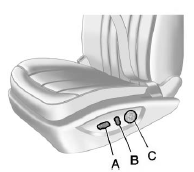Seat Adjustment
Manual Seats

A. Seatback Recline Lever
B. Height Adjustment Switch
C. Seat Position Handle
To adjust the seat position:
1. Pull the handle (C) under the front of the seat cushion.
2. Slide the seat to the desired position and release the handle.
3. Try to move the seat back and forth to be sure it is locked in place.
Press and hold the top or bottom of the switch (B) to raise or lower the seat. Release the switch when the desired height is reached.
To raise or recline the seatback, use the lever (A) on the outboard side of the seat. See Reclining Seatbacks.
Power Seats

A. Power Seat Adjustment Control
B. Reclining Seatbacks
C. Lumbar Adjustment
To adjust a power seat, if equipped:
► Move the seat forward or rearward by sliding the control (A) forward or rearward.
► Raise or lower the front or rear part of the seat cushion by moving the front or rear of the control (A) up or down.
► Raise or lower the entire seat by moving the control (A) up or down.
See Power Seat Adjustment for more information.
To raise or recline the seatback, tilt the top of the control (B) forward or rearward. See Reclining Seatbacks.
Press the front or rear of the control (C) to increase or decrease lumbar support. See Lumbar Adjustment.
See also:
Hill and Mountain Roads
Driving on steep hills or through mountains is different than driving on flat or rolling terrain. Tips for driving in these conditions include:
► Keep the vehicle serviced and in good shape.
...
If You Do Decide To Pull A Trailer
If you do, here are some important points:
• There are many different laws, including speed
limit restrictions, having to do with trailering.
Make sure your rig will be legal, not only where
...
Traction – AA, A, B, C
The traction grades, from
highest to lowest, are AA, A, B,
and C. Those grades represent
the tire's ability to stop on wet
pavement as measured under
controlled conditions on
specified gov ...


